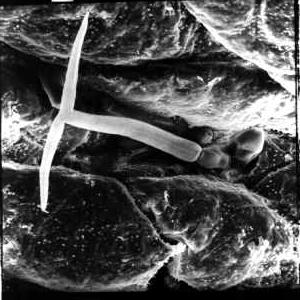
Penetrating cercariae of Trichobilharzia ocellata

Penetrating cercariae of Trichobilharzia ocellata |
We have analysed, how the cercariae find, recognize and invade the hosts
skin in the human parasite species Schistosoma mansoni, S. haematobium, S.
japonicum, in the bovine parasite S. spindale and in the duck parasite
Trichobilharzia ocellata. Each of these species has its particular strategy of
host-finding with very specific and sensitive responses to various chemical and physical host
cues during the host-finding phases. We presently try to find out, why each of the
schistosomatid species has its own strategy to find its host. This high diversity of
host-finding strategies among the schistosomatids may reflect adaptations for a maximal
transmission success within differing ecological habitats. We also try to use our results for
the development of a novel specific control method. A useful fact is, that the cercariae of
all schistosomatid species studied penetrate into their host's skin by responding with extreme
sensitivity to particular fatty acids of the skin. The fatty acids stimulate together with the
penetration behavior a transformation of the cercarial body wall (for immune evasion) and the
organisms become osmotically vulnerable and die, unless they have an opportunity to penetrate
a host. This occurs also in free swimming cercariae, and the parasites lose their infectivity
in the presence of an appropriate fatty acid in a concentration as low as 0.7 ppm.